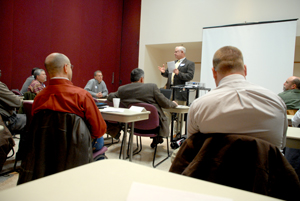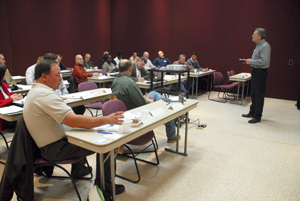NRCS Listening Session 2011
NRCS in Oklahoma Receives Praise, Constructive Suggestions and Ideas for the Future

The USDA Natural Resources Conservation Service held a listening session at Metro Tech in Oklahoma City on Jan. 11 and 12, 2011. Ron Hilliard, NRCS state conservationist for Oklahoma and members of his administrative staff from the state headquarters in Stillwater were in attendance. Larry Wright, Great Plains Resource Conservation and Development Council coordinator for NRCS, facilitated the two-day session.
The purpose of the listening session was to seek input from agricultural and environmental organizations as well as partnering governmental organizations. Representatives of these groups were given an opportunity to respond to the following four questions:
1. What is working well in Oklahoma regarding conservation assistance?
2. What is not working regarding the assistance that NRCS provides to private landowners?
3. What changes does NRCS need to implement that would address what is not working?
4. What should NRCS do in the future to better serve their clients and resource base in Oklahoma?
The groups and governmental entities participating were the following:
- Commissioners of the Land Office
- Ducks Unlimited
- Langston University
- Noble Foundation
- Oklahoma Conservation Commission
- Oklahoma Department of Wildlife Conservation
- Oklahoma Prescribed Fire Council
- Oklahoma Rural Water Association
- Oklahoma State University
- Playa Lake Joint Venture
- Poultry Federation
- Soil and Water Conservation Society
- USDA Farm Service Agency
- U.S. Fish and Wildlife Service

There was general consensus that NRCS had a positive reputation with landowners and producers and had valuable technical capabilities. NRCS received high marks for their efforts to partner with and get input from other state and federal agencies and organizations such as the State Technical Committee. Also, the locally-led process was acknowledged as a positive. It was agreed that having a staffing presence in all 77 counties was important for conservation assistance to landowners. Several participants who have experience working in other states said that things work much better in Oklahoma. It was stated that work done in litter transport had been a beneficial effort in broadening the understanding of the value of poultry litter as a resource as fertilizer.
On the topic of what is not working regarding assistance to private landowners, the issue was raised of challenges NRCS faces in delivering technical assistance outside Farm Bill programs. Another issue raised was the amount of time required of NRCS staff working the office compared to time spent in the field with landowners. Other issues included the challenge of communicating new program information to landowners and providing technical assistance to small acre tract operations, hobby farmers and absentee landlords. Another comment was that there are so many programs now that it confuses people. “How can NRCS offer such a wide array of programs and maintain high quality technical assistance?” it was asked. Good programs like EQIP should be broadened and focus on that, it was suggested. It was also stated that there are too many components required of landowners who generally only have a few objectives they would like to accomplish in their conservation programs. Another comment was that the Conservation Reserve Program was a valuable program but participation was challenged by restrictions on landowners and yearly contract modifications.
In the area of changes and what NRCS should do in the future, the suggestion was supported on several sides to reduce the amount of paper and computer work required of NRCS technical assistance staff in favor of more time free to work in the field one-on-one with landowners. It was suggested that NRCS share its success stories about the benefits to the state’s natural resources, and through that to the public, and demonstrating that public funds spent on private land conservation have measurable benefits that policymakers and citizens can understand.
Hilliard posed the question to participants how changes in the use of technology and social media could be used to reach and serve customers. Responses included more interactive tools and information on the Web including the ability to apply for programs, information to reach and involve younger audiences and to motivate urban audiences to implement best management practices in urban and suburban locations.
Overall the NRCS received high marks from meeting participants on their program delivery and performance.
